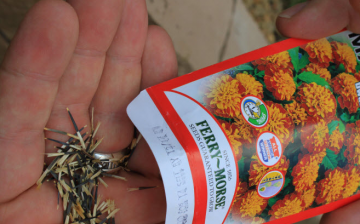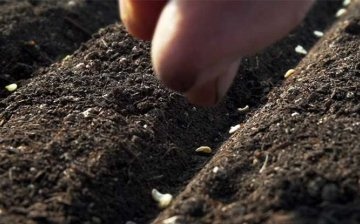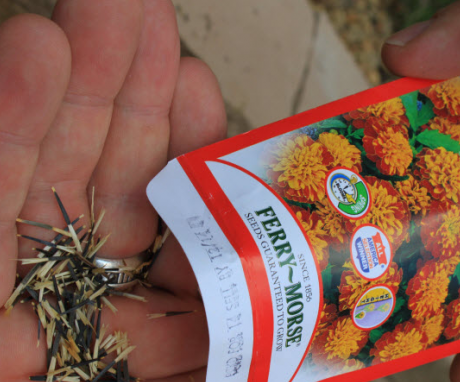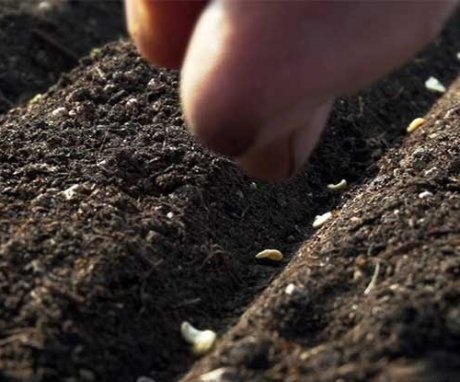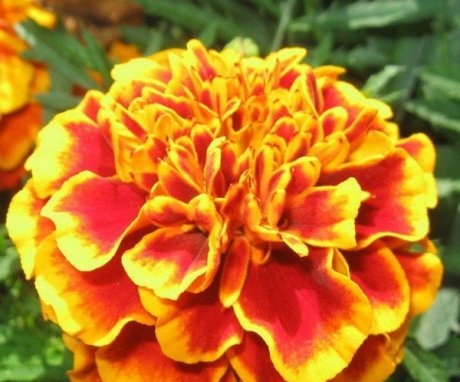A guide to the correct sowing of marigolds for the winter for beginner florists
Marigolds have 50 varieties, differing in size and shade of inflorescences. This is a thermophilic culture. Due to the unique combination of aesthetic qualities and unpretentiousness, the plant can be found in almost every courtyard. However, not everyone knows that it is possible to sow seeds in open ground in the fall. We will tell you about the rules for sowing marigolds before winter.
Is it possible to sow marigolds before winter
Gardeners breed marigolds mainly by planting seedlings or sowing seeds in spring in open ground. At the same time, residents of regions with a warm climate have the opportunity to carry out planting work in the fall. At slight subzero temperatures, the seeds winter well. As soon as the ground warms up after the cold weather, friendly shoots appear on the flower beds.
Despite the low frost resistance of the plant, gardeners living in regions with a cool climate are also experimenting with the autumn sowing of marigolds. Some of them achieve excellent results, due to the arrangement of the covering layer and thick snow cover.
Advantages and disadvantages of sowing before winter
Sowing marigold seeds before winter is characterized not only by convenience, but also by practical benefits. Key benefits include:
- the sprouts are hardened, resistant to adverse weather conditions, which means that the plants will hurt less;
- with the onset of spring, there is no need to follow the sowing schedule, the choice of suitable days, seedlings appear themselves under the dictation of nature itself;
- young shoots develop intensively, forming a strong root system, as a result, healthy bushes are obtained;
- reduction of labor costs for growing seedlings at home, no need to force windows, organize additional lighting;
- sowing in autumn produces hardy plants that can thrive in drought and cool weather.
An overspending of planting material stands out from the significant disadvantages. The place for sowing marigolds is spacious, so that there is enough for all the seeds. Some of them will not stand the frost. The problem in consumption is absent for those gardeners who collect rosettes of dry inflorescences from their flower beds.
Landing dates
If the planting of marigold seeds is planned for the fall, it is important to correctly calculate the timing. The seed is introduced into the ground after the initial stage of its freezing. In this case, the risk of heat return should be unlikely. If a thaw comes unexpectedly, the moisture and heat will cause the seeds to rot and die.
Auspicious days according to the lunar calendar
Experienced gardeners, when determining the date of planting seeds, are guided by the lunar calendar. When reviewing it, you should avoid the days falling on the full moon, new moon. An intermediate period between them is considered favorable. Recommended sowing days for marigolds in the fall of 2020:
- October - 7-10; 21-24;
- November - 6-9; 19-22;
- December (for the southern regions) - 16; twenty; 21; 25; 26.
Site selection and preparation
The culture is unpretentious to the type of soil. But, given the special landing conditions, preference should be given to sites on a hill. In a lowland, during a thaw, the level of groundwater rises, which can provoke rotting of seeds. Clay soil is lightened with peat and sand.
Advice! When choosing a place for marigolds, there is no need to focus on the degree of illumination. Flowers grow well in a sunny area and in the shade.
The soil is prepared in September. For this, all plant residues are removed from the garden. The soil is well moistened, rotted manure or compost is introduced to increase fertility. After 1-2 weeks, deep grooves are made. During disembarkation, soil will be introduced into them, stored in a warm room.
Seed
When planting plants in spring, gardeners prepare the seeds in advance. To do this, they are germinated in a damp cloth, which speeds up the germination process. When conducting sowing marigold seeds this procedure is not required in the fall.
Early sprouting will kill the shoots in the first frost. It is enough to sort out the planting material, sorting out the damaged and wet specimens. You also need to pay attention to the prescription of the collection of seeds. If they were harvested more than 3 years ago, the germination percentage will be low. A material that is no more than 2 years old has a better chance of germination.
Reference! Marigold seeds do not need stratification. When they are planted in autumn, they go through an identical procedure while in the ground.
How to properly plant marigolds before winter
You need to start planting after frosty days or snow falls. Prepared grooves are cleared of debris and snow carpet, if any.
What is needed
You will need soil for work. It is better to take a lightweight substrate fertilized with organic matter. You will also need:
- a mixture of peat with sand or humus with sand;
- scoop;
- dry foliage;
- covering material (agrofiber).
Insulation material can be dispensed with if the landing is done in regions with a warm climate.
Sowing step-by-step instructions
- A loose substrate is introduced into the grooves, which was stored in a warm room. Layer thickness - 1-2 cm.
- The planting scheme is chosen depending on the variety of marigolds, or rather, on their size. But taking into account natural losses from frost, the seeding rate is doubled.
- Seeds are spread on a bedding.
- A small layer of a mixture of peat and sand (humus and sand) is poured over the planting material. The thickness of the substrate should not exceed 3-4 cm. There is no need to compact the soil, otherwise it will be difficult for the sprouts to break through.
- The seeding area is covered with mulch. Dry leaves, peat or sawdust are used as mulch.
- When growing marigolds in regions with a harsh climate, agrofibre is laid on top of the mulch. At the edges, the material is compacted with bricks or boards so that the wind does not blow away the shelter.
With the arrival of spring, the insulation material is removed, the soil is cleared of mulch. This prevents pre-heating of seeds, facilitates the process of germination of seedlings.
Care after landing
Immediately after sowing in autumn, there is no need to moisten the soil, loosen the soil or apply fertilizers. Seeds in their natural environment undergo a slow stratification process. In the spring, when the first shoots appear, the usual activities for the care of young shoots are resumed.
- If the winter was little snow, and in the spring the rains do not sufficiently moisten the soil, there is a need for irrigation. For irrigation, take the settled water. The liquid temperature should be within 20 degrees. A cold shower inhibits plant development.
- As the flower beds become contaminated with weeds, weeding is performed. At first, this should be done with your hands, so as not to damage the forming marigolds with the tool.
- It is necessary to apply fertilizers to the garden planted with marigolds three times per season. For these purposes, complex formulations enriched with potassium, phosphorus, nitrogen and other useful minerals are suitable. The first feeding is done when the shoots reach a height of 10 cm. The second time the planting is fertilized during the formation of buds. There is an acute need for the nutrient mixture even during the flowering period. Such care guarantees a lush flowering throughout the warm season.Agricola-7 is used as a fertilizer for sunny flowers. To prepare the nutrient solution, a tablespoon of the composition is mixed with water (10 l).
- Marigolds are used as pest repellent plants that affect garden crops. The flowers themselves can attract spider mites if there is insufficient air humidity. Timely prevention will help to prevent the invasion of parasites. To do this, the bushes are sprayed with infusion of garlic, red pepper, onion husks or wormwood. If it is not possible to avoid the appearance of insects, insecticides are used.
- Of the diseases, the greatest threat is gray rot. It infects plants during prolonged rains. To reduce the risk of infection of marigolds with a fungus, proper planting will help, excluding thickening of the flower bed.
- As new inflorescences form, old ones that have completed flowering must be removed from the bushes. A similar cleaning of marigolds is carried out when the foliage turns yellow from the lower tiers, and is affected by a fungus.
Reference! Marigolds planted before winter bloom 1-3 weeks earlier than seeds sown in spring. When installed over the shoots of a greenhouse, you will be able to enjoy the first inflorescences already at the end of May - beginning of June.
Preparing for winter
At the end of the flowering period, marigolds are ready to give seeds. There is no need to leave the bushes in the flowerbed, because the plants are annual crops. In dry weather, you need to collect seeds, which are located in the central part of the inflorescences.
It is important not to be late with the collection, in dry weather they can simply spill out on the ground. It is important to take into account that the planting material of hybrid varieties does not retain parental qualities. But they make no less beautiful marigolds.
The seeds ripen approximately 40 days after the plant enters the flowering phase.
Experienced gardening tips
The advice of experienced gardeners will help to avoid mistakes when planting marigolds before winter.
- You should not save planting material when sowing marigolds before winter. It is better to plant seedlings in other flower beds in the spring. It is impossible to predict what frosts will be in winter. Weak seeds die at low temperatures.
- For the reproduction of marigolds, it is recommended to use seeds not older than two years. Friendly shoots are obtained from them.
- If there is a desire to get the earliest flowering, after the arrival of spring, a film greenhouse is installed on the site with planting. Marigolds develop faster in such conditions.
- The following types of marigolds are most suitable for planting before winter: thin-leaved, erect, rejected.
- In summer, when the bush is actively growing, pruning can be done to give the flower an interesting shape. After this procedure, the plant develops even more intensively.
- When choosing a place for marigolds, areas with a low groundwater table are well suited. It is also worth considering the option with a site that has a slight slope.
Planting marigold seeds before winter is an exciting activity that does not require much labor and investment. A plethora of new methods allows gardeners to experiment who want to grow a beautiful flower in regions with unfavorable climates. The lush, bright bloom will not only be a decoration of the yard, but also a reward for your efforts.
Related videos:




